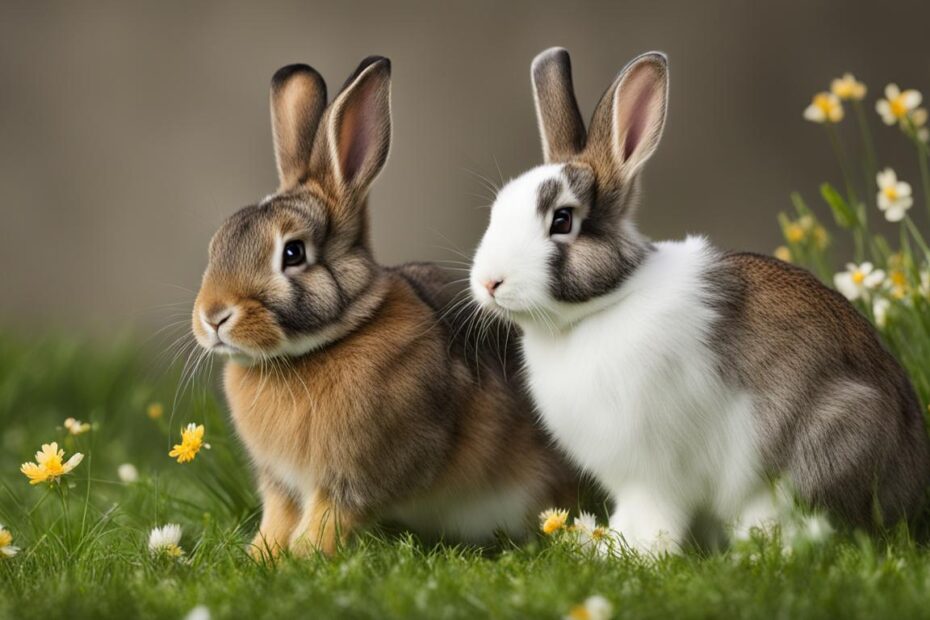Are you considering getting a rabbit but worried about excessive shedding? Look no further! In this article, we’ll explore the breeds of rabbits that shed the least. Whether you’re looking for low shedding rabbit breeds or hypoallergenic rabbit options, we’ve got you covered.
According to experts, including the National Angora Rabbit Breeders Club, Angora rabbits are believed to shed the least among rabbit breeds. Their selectively bred long and luxurious fur contributes to minimal shedding. While no rabbit breed is completely hypoallergenic, Angora rabbits are often more suitable for individuals with allergies due to the nature of their fur.
Key Takeaways:
- Angora rabbits are known for shedding the least among rabbit breeds.
- No rabbit breed is completely hypoallergenic, but Angora rabbits may be more suitable for individuals with allergies.
- Regular grooming is essential to maintain a rabbit’s coat and reduce shedding.
- Consider the lineage, nutrition, and environment when selecting a rabbit with minimal shedding tendencies.
- Managing stress levels and providing a balanced diet can help minimize shedding in rabbits.
Which Rabbits Shed the Least
Angora Rabbits
Angora rabbits are known for their long, silky fur which requires regular grooming to prevent matting. Despite their long hair, Angora rabbits are reported to shed less than other breeds due to their fur being bred for its quality and the fact that it is regularly collected for use in clothing and products. Regular brushing and trimming are necessary to keep their coats in good condition.
In addition to their low shedding tendencies, Angora rabbits are also considered low maintenance compared to other breeds. Their fur grows continuously, which means they do not require frequent trips to the grooming salon for haircuts. However, their long hair does require regular brushing to prevent tangles and matting. It’s important to use a gentle brush specifically designed for rabbits to avoid causing any discomfort or injury to the rabbit’s skin.which rabbits shed the least
Angora rabbits have a unique and luxurious coat that adds to their appeal as pets. Their long, soft fur requires regular attention to keep it looking its best. Despite their high-maintenance appearance, Angora rabbits are known for shedding less than other long-haired breeds, making them a popular choice for individuals looking for low maintenance rabbit breeds.
If you are considering getting an Angora rabbit, it’s important to keep in mind their grooming needs and the time commitment required to keep their fur in optimal condition. Regular grooming sessions can be a bonding experience for you and your rabbit and help ensure their coat remains clean and healthy. With proper care, Angora rabbits can be a beautiful addition to your family.minimal shedding rabbits
Mini Rex Rabbits: Low Shedding and Low Maintenance
When it comes to finding a rabbit breed that sheds minimally, Mini Rex rabbits are a popular choice. These adorable creatures have a dense and soft coat of short hair, which not only contributes to their cute appearance but also makes them low shedding rabbits. While they may still shed like all rabbits, their shorter hair makes the shedding process less noticeable and easier to manage.hypoallergenic rabbit breeds
Regular grooming is still essential for maintaining the health and appearance of Mini Rex rabbits. Brushing their coat at least once or twice a week helps remove loose hair and prevents matting. Additionally, occasional trimming of their nails and cleaning of their ears are necessary for overall hygiene.
Mini Rex rabbits are known for being relatively low maintenance when it comes to their grooming needs. Their shorter hair makes it easier to keep them looking tidy, and their small size makes them easier to handle during grooming sessions. With proper care and attention to their grooming routine, Mini Rex rabbits can continue to have a healthy and beautiful coat with minimal hair loss.
A Comparison of Low Shedding Rabbit Breeds
| Rabbit Breed | Hair Length | Shedding Level | Grooming Needs |
|---|---|---|---|
| Angora Rabbits | Long | Minimal | Regular grooming and trimming |
| Mini Rex Rabbits | Short | Low | Regular brushing and occasional trimming |
| Plush Lop Rabbits | Medium | Low | Regular brushing and occasional trimming |
| Velveteen Lop Rabbits | Medium to Long | Low to Moderate | Daily grooming and cleaning of ears |
As shown in the table above, Mini Rex rabbits are categorized as having short hair, which directly correlates with their low shedding level. This makes them a suitable choice for individuals who prefer a rabbit breed with minimal hair loss. However, it is important to note that grooming needs may vary between breeds, and regular attention to their coats is still necessary to keep them healthy and looking their best.rabbits with minimal hair loss
Plush Lop Rabbits: A Low-Shedding and Hypoallergenic Pet Option
Plush Lop rabbits, also known as Holland Lop or Mini Lop rabbits, are a popular choice for individuals seeking low-shedding rabbit breeds or hypoallergenic pets. These adorable rabbits possess a unique fur that is known to shed less compared to other breeds. While no rabbit can be truly hypoallergenic, Plush Lop rabbits are less likely to cause allergic reactions in sensitive individuals due to their reduced shedding.
Unlike some breeds with longer fur, Plush Lop rabbits have a coat that is typically less prone to shedding. This can be attributed to their linage, which combines the Holland Lop, Mini Rex, and Mini Lop breeds. The specific combination of these breeds results in a fur texture that sheds less, making them a great choice for individuals who may have allergies or prefer a pet with minimal hair loss.
When considering a Plush Lop rabbit as a pet, it is important to note that regular grooming is still necessary to maintain their fur in good condition. While they may shed less, their coat still requires brushing and occasional trimming to prevent matting and keep it healthy. Grooming sessions can also provide an opportunity for bonding and building a relationship with your furry companion.
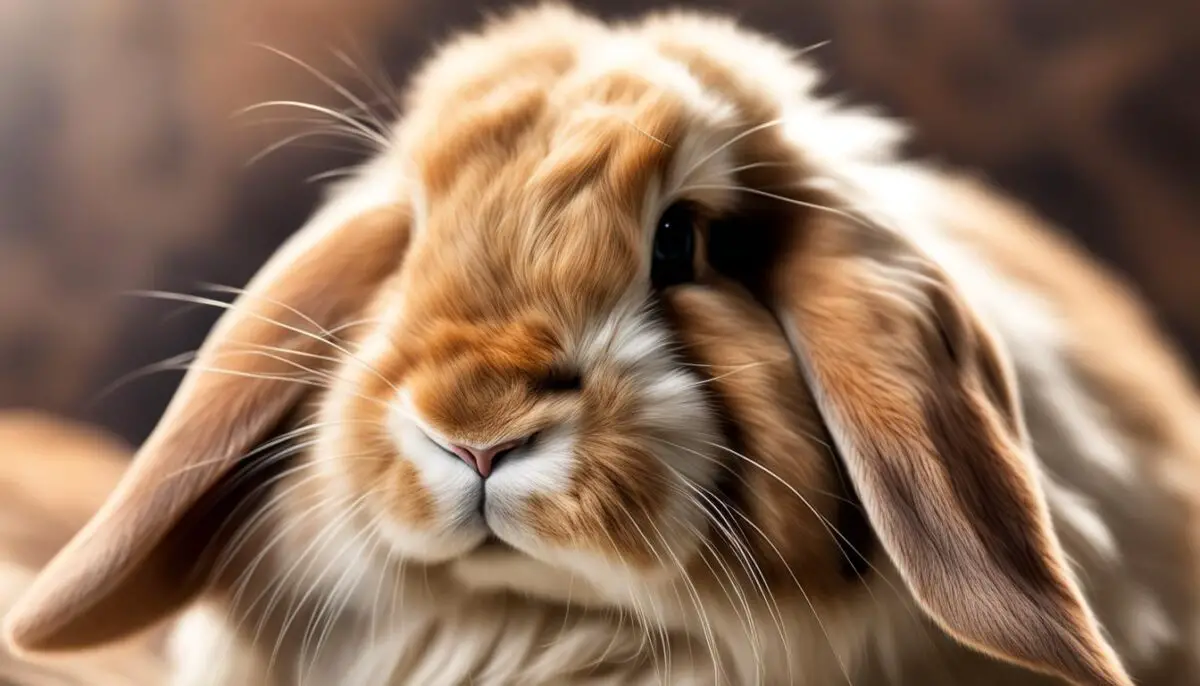
Table: Comparison of Shedding Levels in Different Rabbit Breeds
| Rabbit Breed | Shedding Level |
|---|---|
| Angora | Low |
| Mini Rex | Minimal |
| Plush Lop | Low |
| Velveteen Lop | Low |
Table: A comparison of shedding levels in different rabbit breeds. While all rabbits shed to some extent, breeds such as Angora, Mini Rex, Plush Lop, and Velveteen Lop are known for their lower shedding tendencies.non-shedding rabbit breeds
In conclusion, Plush Lop rabbits offer a wonderful option for individuals seeking a low-shedding and hypoallergenic pet. With their adorable appearance and minimal shedding, they can be a great choice for families and individuals alike. Remember to provide regular grooming and care to ensure their fur remains in good condition. Consult with breeders or experienced rabbit owners to learn more about Plush Lop rabbits and their specific care needs.
Velveteen Lop Rabbits
Velveteen Lop rabbits are a delightful breed known for their soft and dense fur. They are a mix between the Mini Rex and English Lop breeds, resulting in a unique and appealing appearance. These rabbits have a plush coat that requires regular grooming to keep it in good condition and minimize shedding.rabbit breeds that don’t shed much
One of the distinguishing features of Velveteen Lop rabbits is their straight and dense fur. This gives them a velvety texture, contributing to their name. While they do shed their coat like all rabbits, regular grooming can help reduce shedding and prevent matting. It is especially important to pay attention to their fur if they are kept outdoors, as they are more prone to ear infections.rabbits with low hair shedding
When grooming Velveteen Lop rabbits, it is recommended to brush them daily to remove loose fur and prevent matting. This will also help distribute the natural oils throughout their coat, keeping it healthy and shiny. Additionally, trimming their fur, especially around the ears, can help prevent tangles and infections. A well-groomed Velveteen Lop rabbit will have a beautiful and low-shedding coat.
Grooming Tips for Velveteen Lop Rabbits
- Brush their fur daily to remove loose fur and prevent matting.
- Trim their fur, especially around the ears, to prevent tangles and infections.
- Clean their ears regularly, especially if they are kept outdoors, to prevent ear infections.
- Provide a balanced diet to promote healthy fur growth and minimize shedding.
- Keep their living environment clean to reduce the amount of fur they come into contact with.
“Regular grooming is essential for Velveteen Lop rabbits to maintain a healthy and low-shedding coat. By brushing and trimming their fur, you can help prevent matting and tangles, while also keeping their ears clean and free from infections. With proper care, these adorable rabbits can have a beautiful and low-maintenance coat.”
| Fur Type | Shedding Level |
|---|---|
| Velveteen Lop | Low |
| Mini Rex | Low to Moderate |
| English Lop | Moderate |
Factors Affecting Rabbit Shedding
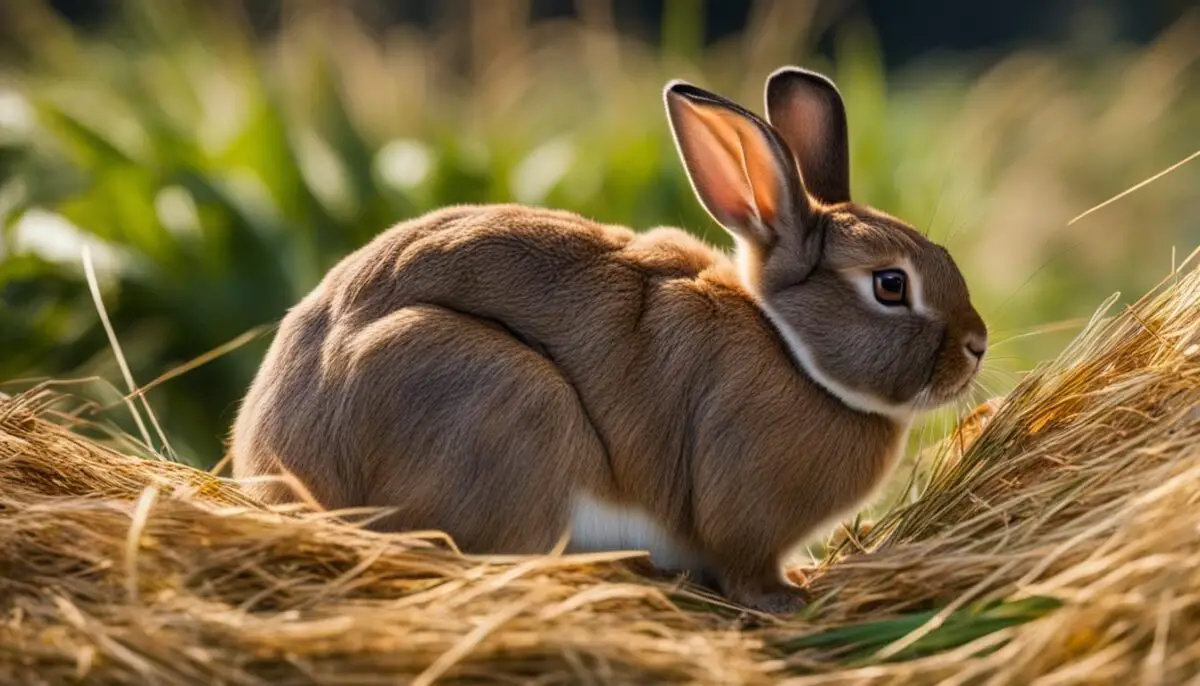
Rabbits shed their fur as part of their natural molting process, which occurs twice a year during the transition between winter and summer coats. This shedding helps rabbits adapt to changing temperatures and maintain a healthy coat. However, the amount of shedding can vary depending on several factors:
- Weather fluctuations: Rabbits may shed more during the transition between seasons, especially when going from a warmer winter coat to a lighter summer coat. Changes in temperature and daylight can trigger increased shedding.
- Stress levels: Stressful situations, such as moving to a new environment or changes in routine, can cause rabbits to shed more. It is important to provide a calm and stable environment for rabbits to minimize stress.
- Grooming: Regular grooming is essential to help rabbits clear away old fur and prevent hairballs. Brushing their coats frequently can reduce shedding and keep their fur in good condition.
- Digestion system: Proper digestion is crucial for rabbits to process and eliminate excess fur. A healthy diet rich in fiber and regular access to fresh water can support their digestion and help prevent excessive shedding.
“With proper grooming and a stress-free environment, you can help reduce shedding in rabbits.”
By understanding these factors and taking appropriate measures, rabbit owners can manage shedding and support their rabbits’ overall well-being. It is important to note that while shedding is a natural process for rabbits, excessive or sudden shedding may indicate underlying health issues, and a veterinarian should be consulted in such cases.
Grooming Tips for Managing Rabbit Shedding:
To help minimize shedding and maintain a healthy coat for your rabbit, follow these grooming tips:
- Regularly brush your rabbit’s fur using a soft brush or comb, especially during shedding seasons.
- Trim your rabbit’s nails regularly to prevent them from getting caught in their fur and causing discomfort.
- Check your rabbit’s ears and clean them if necessary to prevent infections that can be caused by excessive fur.
- Provide a balanced diet with plenty of hay for proper digestion and fur health.
- Create a calm and stress-free environment for your rabbit by providing appropriate housing, social interaction, and minimizing sudden changes to their routine.
Table: Factors Affecting Rabbit Shedding
| Factors | Description |
|---|---|
| Weather fluctuations | Changes in temperature and daylight can trigger increased shedding. |
| Stress levels | Stressful situations can cause rabbits to shed more. |
| Grooming | Regular grooming helps remove old fur and reduce shedding. |
| Digestion system | Proper digestion supports the elimination of excess fur. |
The Importance of Grooming
Grooming plays a vital role in maintaining a rabbit’s coat and reducing shedding. Regular brushing and trimming help prevent matting and keep the fur in good condition. It is recommended to brush rabbits at least twice a week when they are not shedding heavily, and increase the frequency to daily during the shedding season.
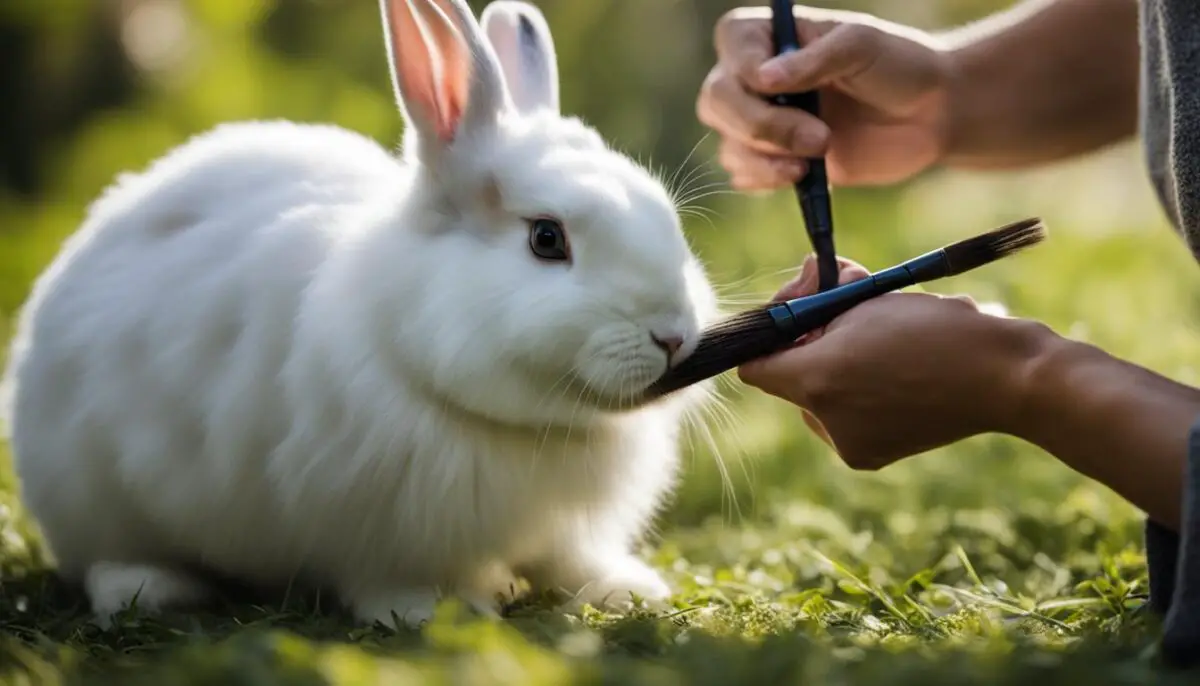
Additionally, providing a balanced diet and plenty of fresh water can contribute to a healthy coat and minimize excessive shedding. Rabbits require a diet that is rich in fiber, such as Timothy hay and fresh vegetables. This helps support their digestive system and promotes healthy fur growth.
Grooming Tips for Rabbits:
- Use a soft-bristled brush or a grooming glove to gently remove loose fur. Be careful not to pull or tug on the fur, as this can cause discomfort and stress to the rabbit.
- Trim the fur around the rabbit’s rear end to prevent matting and keep the area clean. This is especially important for long-haired breeds like Angora rabbits.
- Check the rabbit’s nails regularly and trim them if they become too long. Overgrown nails can cause discomfort and difficulty in mobility.
- Pay attention to the rabbit’s ears and eyes. Clean any discharge or debris gently with a damp cloth. If you notice any signs of infection or discomfort, consult a veterinarian.
In addition to regular grooming, it is important to monitor your rabbit’s overall health and behavior. Sudden changes in shedding patterns or excessive shedding may indicate an underlying health issue and should be addressed by a veterinarian. By providing proper care and grooming, you can help keep your rabbit’s coat healthy and reduce shedding to a minimal level.
Rabbits and Allergies
Allergies can be a concern for individuals considering rabbits as pets. While no rabbit breed is completely hypoallergenic, it is important to understand the relationship between rabbits and allergies to make an informed decision. Contrary to popular belief, it is not the rabbit’s fur itself that causes allergic reactions, but rather specific proteins found on the fur.
“It is not the fur itself that triggers allergies, but rather the proteins found on the fur.”
When rabbits groom themselves, these proteins can become airborne and cause allergic reactions in sensitive individuals. Common symptoms of rabbit allergies can include sneezing, coughing, watery eyes, and skin rashes. For those with mild allergies, regular grooming and keeping the rabbit’s environment clean can help minimize exposure to fur proteins and reduce the risk of allergic reactions.
| Breed | Allergy Level | Notes |
|---|---|---|
| Angora Rabbits | High | Their long fur may carry more allergens, requiring increased grooming and cleaning. |
| Mini Rex Rabbits | Low | Shorter hair and less grooming may result in less exposure to allergens. |
| Plush Lop Rabbits | Medium | Their unique fur may carry some allergens, but regular grooming can help manage exposure. |
| Velveteen Lop Rabbits | Medium | Their dense fur requires daily cleaning and grooming to minimize allergen buildup. |
It is important to note that individual sensitivities can vary, and what may cause an allergic reaction in one person may not affect another. If you have severe allergies, it is recommended to spend time with different rabbit breeds before making a decision. Consulting with breeders or experienced rabbit owners can provide valuable insights and assistance in finding a rabbit that is better suited for individuals with allergies.
How to Choose a Low-Shedding Rabbit
When it comes to selecting a low-shedding rabbit, there are several factors to consider. Paying attention to the rabbit’s lineage, nutrition, weather fluctuations, and stress levels can help you choose a rabbit breed that sheds less. By taking these factors into account, you can find a rabbit that fits your lifestyle and minimizes the amount of shedding in your home.
One important aspect to consider is the rabbit’s lineage. Some breeders focus on selectively breeding for rabbits with minimal shedding tendencies. Inquiring about a rabbit’s lineage can give you an idea of its shedding potential. Breeds such as Angora, Mini Rex, Plush Lop, and Velveteen Lop rabbits are often recognized for their minimal shedding characteristics.
Nutrition also plays a role in a rabbit’s shedding patterns. Providing a balanced diet that meets their nutritional needs can contribute to a healthy coat. Ensure that your rabbit receives an appropriate amount of fresh hay, fresh vegetables, and a small portion of pellets to maintain their overall health and reduce shedding.
Additionally, managing environmental factors such as weather fluctuations and stress levels can impact a rabbit’s shedding. Extreme temperature changes and stressful situations can trigger shedding. Providing a stable and comfortable environment for your rabbit can help minimize shedding. Creating a consistent routine and providing a safe and quiet space for your rabbit can also help reduce stress levels, ultimately contributing to less shedding.
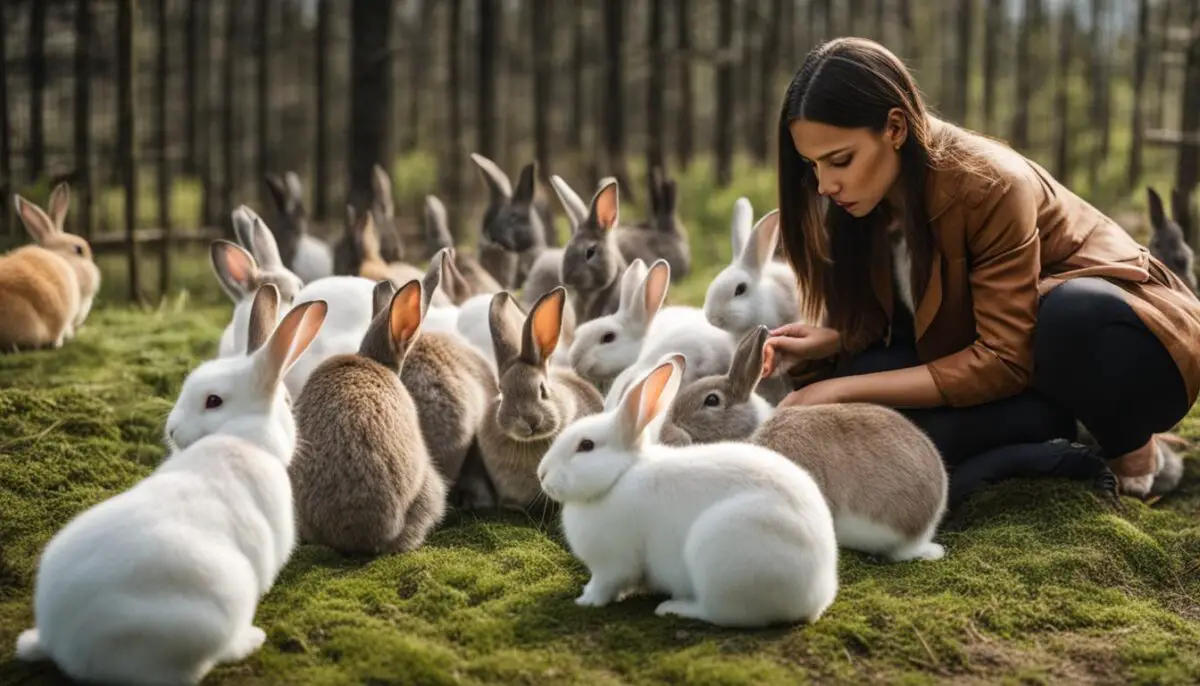
Table: Comparison of Low-Shedding Rabbit Breeds
| Rabbit Breed | Shedding Level | Main Characteristics |
|---|---|---|
| Angora | Minimal | Long and luxurious fur |
| Mini Rex | Low | Dense and soft coat of short hair |
| Plush Lop | Minimal | Less prone to shedding compared to other breeds |
| Velveteen Lop | Low | Soft, straight, and dense fur |
“By considering the lineage, nutrition, weather fluctuations, and stress levels, you can choose a rabbit breed that sheds less and is better suited to your lifestyle. Taking these factors into account when selecting a low-shedding rabbit can make a significant difference in the amount of fur you’ll find around your home.”
– Rabbit Expert
Choosing a low-shedding rabbit involves careful consideration of various factors. By researching a rabbit’s lineage, providing a balanced diet, and managing environmental factors, you can minimize shedding and maintain a cleaner home. Remember to consult with breeders or experienced rabbit owners for additional guidance on choosing the right low-shedding rabbit for you.
Managing Rabbit Shedding
Rabbits naturally shed their fur as part of their molting process, but there are measures you can take to manage and minimize shedding. Regular grooming is essential to remove loose fur and prevent matting. This includes brushing your rabbit’s coat at least twice a week when they are not shedding heavily, and increasing the frequency to daily during shedding seasons. Trimming your rabbit’s fur can also help keep it in good condition and reduce shedding.
Nutrition plays a crucial role in managing shedding. Providing a balanced diet that includes high-quality hay, fresh vegetables, and a small amount of pelleted food can contribute to a healthy coat and minimize excessive shedding. It’s important to consult with a veterinarian to ensure your rabbit’s diet meets their specific nutritional needs.
In addition to grooming and nutrition, environmental factors can affect shedding. Fluctuations in weather and temperature can trigger shedding, so it’s important to keep your rabbit in a stable and comfortable environment. Stress can also contribute to excessive shedding, so be mindful of your rabbit’s stress levels and provide them with a calm and secure living space.
Reducing Rabbit Shedding Tips:
- Regularly groom your rabbit by brushing their coat and trimming their fur.
- Provide a balanced diet with high-quality hay, fresh vegetables, and a small amount of pelleted food.
- Keep your rabbit in a stable and comfortable environment, minimizing fluctuations in weather and temperature.
- Manage your rabbit’s stress levels by providing a calm and secure living space.
By following these tips, you can effectively manage and minimize your rabbit’s shedding, keeping their coat healthy and reducing the amount of loose fur in your home.
| Managing Rabbit Shedding Tips | Benefits |
|---|---|
| Regular grooming | Removes loose fur and prevents matting |
| Providing a balanced diet | Promotes a healthy coat and minimizes excessive shedding |
| Maintaining a stable environment | Reduces weather and temperature-related shedding |
| Managing stress levels | Decreases shedding caused by stress |
Rabbit Shedding Myth and Reality
When it comes to rabbit shedding, there are several myths and misconceptions that have been circulating among rabbit owners. While some sources claim that certain breeds shed less than others, personal experiences and various factors can influence shedding characteristics in rabbits. It is important for rabbit owners to understand the reality behind these myths and manage shedding based on the specific needs of their furry friends.
Myth: Certain breeds of rabbits shed less than others.
Many rabbit owners have heard that breeds like Angora and Mini Rex rabbits shed less than other breeds. While these breeds may have characteristics that make their shedding less noticeable, shedding can still occur depending on various factors such as nutrition, weather fluctuations, and stress levels. It is essential to remember that shedding is a natural process for all rabbits and can vary from individual to individual.
Reality: Shedding characteristics can be influenced by multiple factors.
Shedding in rabbits can be influenced by a variety of factors beyond breed alone. Factors such as nutrition, weather changes, stress levels, and grooming practices can affect the amount and frequency of shedding. Additionally, rabbits may shed more during certain times of the year as they transition between their winter and summer coats. Understanding these factors and providing proper care can help manage shedding in rabbits.
Personal experiences: The importance of observing individual rabbits.
While generalizations can be made about shedding tendencies based on breed characteristics, it is important to remember that each rabbit is unique. Individual rabbits may have different shedding patterns, even within the same breed. Personal experiences and observations of an individual rabbit’s shedding habits can provide valuable insights into their specific needs. By closely monitoring your rabbit’s shedding patterns and adjusting grooming practices accordingly, you can help keep their coat healthy and minimize shedding.
| Myth | Reality |
|---|---|
| Certain breeds shed less | Shedding influenced by various factors |
| Shedding varies based on breed alone | Shedding patterns vary for individual rabbits |
| Minimal shedding breeds exist | Shedding is a natural process for all rabbits |
Conclusion
While no rabbit breed can be guaranteed to shed less than others, there are several breeds that are commonly regarded as having minimal shedding tendencies. These breeds include Angora, Mini Rex, Plush Lop, and Velveteen Lop rabbits. These rabbits have been selectively bred for their fur quality and have hair that is less prone to shedding compared to other breeds.
Regular grooming is essential to help reduce shedding and keep the rabbits’ coats in good condition. This includes brushing and trimming their fur to prevent matting. Additionally, providing a balanced diet and managing environmental factors such as weather fluctuations and stress levels can also contribute to reducing shedding in rabbits.
When choosing a rabbit with minimal shedding, it is important to consider individual characteristics and consult with experienced breeders or rabbit owners. While there may be some variation in shedding tendencies among individuals, following proper grooming and care practices can help minimize shedding and ensure a healthy and happy rabbit.
FAQ
Which rabbit breeds shed the least?
Angora rabbits are believed to shed the least among rabbit breeds, followed by Mini Rex, Plush Lop, and Velveteen Lop rabbits.
Are Angora rabbits hypoallergenic?
While no rabbit breed is completely hypoallergenic, Angora rabbits may be more suitable for individuals with allergies due to the nature of their fur.
Do Mini Rex rabbits shed less than other breeds?
Mini Rex rabbits have a shorter and denser coat, making the shedding process less noticeable and easier to manage.
Are Plush Lop rabbits hypoallergenic?
Plush Lop rabbits may be a good option for individuals with allergies, as they are less likely to cause allergic reactions compared to cats and dogs.
How much do Velveteen Lop rabbits shed?
Velveteen Lop rabbits shed their coat like all rabbits, but regular grooming can help reduce shedding. Their long fur requires daily cleaning and grooming, especially if kept outdoors.
What factors affect rabbit shedding?
Rabbit shedding is influenced by factors such as weather fluctuations, stress levels, and the molting process that occurs twice a year.
How important is grooming for rabbits?
Regular grooming, including brushing and trimming, is vital to maintain a rabbit’s coat and reduce shedding.
Can rabbits cause allergies?
While no rabbit breed is completely non-allergenic, managing grooming and minimizing exposure to fur proteins can help reduce the risk of allergic reactions in sensitive individuals.
How to choose a low-shedding rabbit?
Factors such as linage, nutrition, and raising conditions can influence a rabbit’s shedding. Inquiring about linage from breeders and providing a balanced diet are important considerations.
How can rabbit shedding be managed?
Regular grooming, proper nutrition, and managing environmental factors such as stress levels can help reduce shedding in rabbits.
Are there myths about rabbit shedding?
There is some debate among rabbit owners, but individual experiences vary, and shedding can be influenced by various factors. It is important to consider individual characteristics and manage shedding based on the specific needs of rabbits.


